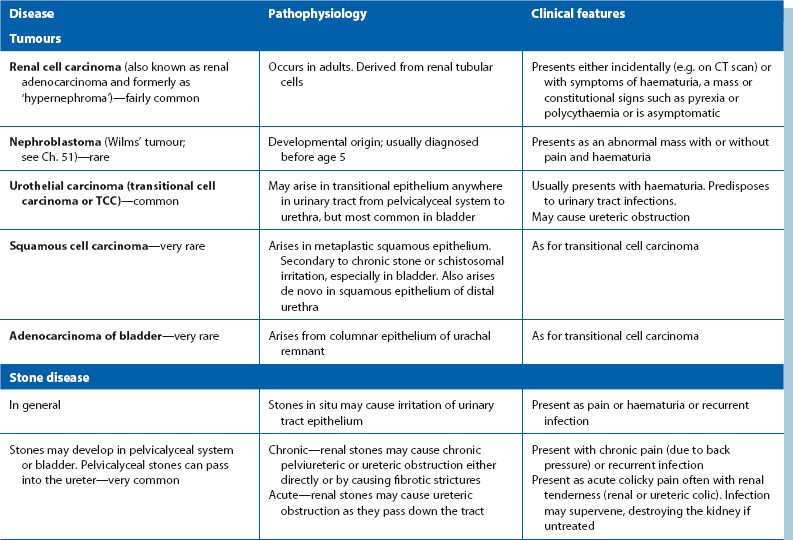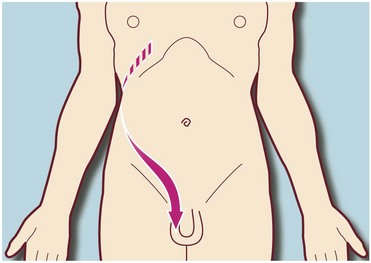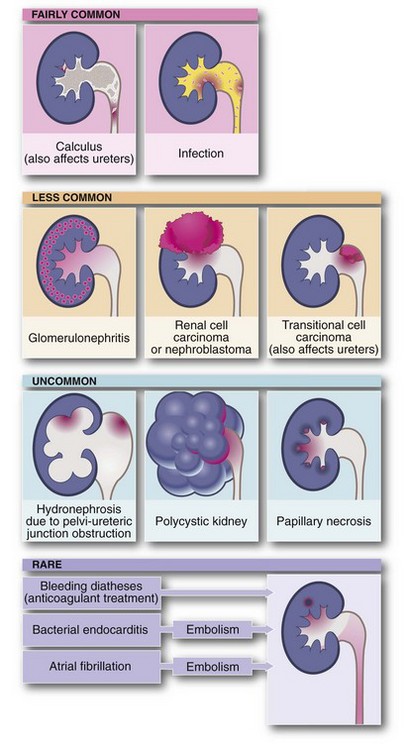Symptoms, signs and investigation of urinary tract disorders
Symptoms of urinary tract disease
Symptoms caused by intrinsic disease of the urinary tract
The important urinary tract tumours, stone diseases and infections are outlined in Table 34.1. Any of these may present with haematuria. Disorders which cause urinary stasis also predispose to urinary tract infection.
Congenital abnormalities may involve the kidneys, ureters, bladder, urethra and genitalia, either alone or in combination. Most of the serious abnormalities are recognised antenatally by ultrasound, at birth or in early childhood. The exceptions are polycystic disease and medullary sponge kidney, which usually present in adulthood. Less serious congenital abnormalities such as duplex systems may predispose to urinary tract infections because of abnormal flow dynamics. These abnormalities may be discovered at any age during investigation of recurrent urinary infections. Congenital disorders which present mainly in adulthood are discussed in Chapter 39 and those presenting mainly in childhood in Chapter 51.
The common symptoms of urinary tract disease
Abdominal pain
Urinary tract disorders may cause abdominal pain with or without urinary symptoms.
Pain arising from the kidneys and upper tract: Both renal inflammation and stretching of the renal capsule cause pain in the renal angle, the posterior gap between the lowest rib and iliac crest. This area may also become tender to palpation or percussion. Renal stones, tumours or polycystic disease may cause dull and persistent loin pain even without obstruction.
Acute upper ureteric obstruction and distension of the pelvicalyceal system produce excruciating loin pain. The pain is colicky (resulting from powerful ureteric peristalsis) and often radiates to the hypochondrium (right or left upper quadrant of the abdomen) or groin (see Fig. 34.1). This pain is known as renal or ureteric colic. When obstruction is low in the ureter, the pain may radiate to the genitalia.
Pain arising from the bladder and lower tract: Pain originating in the bladder (e.g. in cystitis) is experienced in the suprapubic area. Pain may be referred to the penis or vulva if the bladder trigone is involved. In adults, urinary symptoms such as dysuria and frequency are usually present as well, but children may have no localising symptoms or complain only of pain, making the diagnosis less obvious. Dysuria is usually the predominant symptom of urethral disorders, but pain arising in the male urethra (e.g. in sexually transmitted infections) is usually referred to the tip of the penis. Finally, the pain of prostatic inflammation (prostatitis) is usually felt deep in the perineum. The prostate is tender on rectal examination in the acute but not the chronic form.
Pain simulating urinary tract disease: Pain from other abdominal pathology may sometimes mimic pain arising from the urinary tract. Acute appendicitis may present with suprapubic pain, and biliary tract pain may be referred to the right thoracolumbar region, while posterior duodenal ulcers and pancreatic disease may cause pain in the central lumbar region. An expanding or leaking abdominal aortic aneurysm may sometimes mimic urinary tract disease, particularly if a ureter is compressed. Diseases of the thoracolumbar spine, such as metastatic cancer, tuberculosis, spondylosis and disc lesions, may also simulate upper urinary tract disorders. Suspected renal colic with a local rash is usually due to shingles (herpes zoster); the rash may not appear for several days after the onset of pain; perineal zoster may cause retention of urine. In women, pain arising from the ovaries or genital tract (e.g. pelvic inflammatory disease) may be confused with bladder pain.











